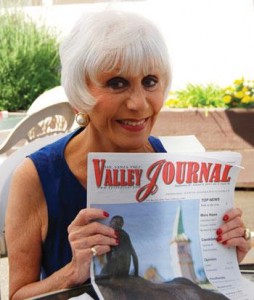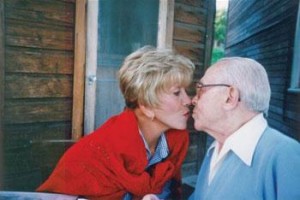
Famed Hollywood interviewer returns to stage in Santa Ynez
By SaraLloyd Truax, Staff Writer
She is doing it again – Rona Barrett is bringing color to a field where before there were only shades of gray. Along the way, she will make you laugh, reminisce and perhaps even touch your heart, if you let her.
will make you laugh, reminisce and perhaps even touch your heart, if you let her.
The woman who forever changed the face of entertainment news is on a mission to change the look and feel of senior care in America. It is a journey that starts here and is funded by her new one-woman show “Rona Barrett: Nothing but the Truth.” The production comes to the Santa Ynez Valley Union High School Theatre at 7 p.m. Oct. 15-16.
Barrett will reveal not only the trials and tribulations of getting to the top, but also how and why she moved celebrities to share their personal lives. She will, of course, include clips from her famous interviews, including those of Lucille Ball, Henry Fonda, Carol Burnett and more, but she will also reveal behind-the-scene details.
Just as important as the show is the motivation behind it. It all started a year ago – a birthday present of sorts from the City of Palm Springs, which honored her with a star on their sidewalk of fame. From there erupted a string of interview and appearance requests. Those got her thinking about what was most important to her, and how she might best use what “voice” she still had. “We are all living longer, but not necessarily better,” Barrett says. “I need to bring awareness for the crisis that’s coming. We don’t have enough of anything.” It is a problem Barrett believes was known and ignored for 50 years.
The shortage is one Barrett experienced firsthand. Almost from the minute her retirement started, women who mentored her, women old enough to be her mother, started slipping into poor health. With no families of their own, or with families too far away or too busy to care for them, Barrett was called on to help. She agreed to do so, but quickly discovered that resources are limited.
Eldercare was hard to locate and lacked, not in caring, but in the capacity to bring a quality to the seniors’ lives that made living those extra years worthwhile. Something else happened to Barrett. Her father came to live with her. Suddenly, she had the chance to get to know him in a way she never had as a child. “I never knew how funny he was growing up,” Barrett says. People he worked with told Barrett that he was, but she never saw it. “He’d come home the same time every night with his paper, and sit down at the dinner table and read it.” There wasn’t much time for talking.
those extra years worthwhile. Something else happened to Barrett. Her father came to live with her. Suddenly, she had the chance to get to know him in a way she never had as a child. “I never knew how funny he was growing up,” Barrett says. People he worked with told Barrett that he was, but she never saw it. “He’d come home the same time every night with his paper, and sit down at the dinner table and read it.” There wasn’t much time for talking.
They made up for it when he moved in, and she took him to lunch every day. It turned out to be a wonderful experience for both – truly something to wish on someone else.
But she was not prepared. “This is a job that has the quickest burnout,” Barrett says. “It’s just not easy taking care of someone who is sick or needs a lot of help.” If she was finding it hard, with all her name recognition and resources, how were seniors with nobody available to help them doing it?
She calls these the “Orphaned Seniors.” They have no voice, Barrett says, ignored by politicians who see them as a population who do not vote. With no family, they are easily disregarded. “There are never enough advocates for the elderly. Lots of people are out there for children,” she says, so she intends to raise her voice for the elderly.
Barrett designed a model program to be built on the Central Coast. She at first thought of naming the project “Harry’s House” in honor of her father, but in the end it will be the project, and not the name, that honors both him and how much the extra time they shared means to her.
The “Golden Inn and Cottages” is an innovative project that will combine housing, adult day care and short-term caregiver respite in a community centered model. It will be funded initially by donations and proceeds from her one-woman show. Barrett intends to work for new tax benefits for corporations in the hope they will begin giving to the elderly.
“What I believe, and what I hope to convey to as many people as I can, is that we should try to take the orphan seniors out of institutional settings and put them into smaller communities. Community life is a big deal,” Barrett says. She wants to give the elderly poor a taste of what the golden years should be.
Her focus is not just seniors, but equally on the caregivers. Respect is the key. “One of the programs I will have is teaching people how to be caregivers. It’s a very big project,” says Barrett. “I’m going to need the help of everyone in this community and elsewhere.”
She has faith in the people of this Valley. She believes that together a program can be established here that can and will be duplicated across the county.
“To me, from the first day I came over the pass, I said ‘Oh my Gosh, this is exactly what I’ve looked for. I know I have to come back here to buy a piece of land.’” She did six weeks later. Barrett soon found the beauty is not just in the land, but also in the people.
“I’m in love with this place,” she says rattling off a list of positive adjectives, too fast to be recorded, that sum up her regard for the Valley and its inhabitants. Plain and simple, Barrett considers this region paradise. It is why she came here and why she has no intention of leaving.
And while the sense of community here is not quite the same as it was growing up in Queens, with family next door or just down the street, Barrett finds a sense of connection in the Valley that is lacking in most of the rest of America. “The family unit has broken down so much,” she says. “Young children today grow up not knowing what it is like to grow up having family around you.” She wants to bring that sense of community to the orphaned seniors, and for them to bring something to this population as well.
“Everyone in this world has a story to tell, but they don’t always have someone to tell it to,” says Barrett. She knew that as she was growing up and maturing into the reporter she is, but she finds it just as true with seniors. There is a lot to be learned and enjoyed from the stories they have to share.
Sharing stories is Barrett’s lifeblood. She enjoys interviewing anyone who has a great story to tell and who is not afraid to tell it. She is much more interested in what makes celebrities tick, rather than the roles they played.
“If I could get a story that could help someone on the other end — that was the kind of story I went for,” Barrett says.
She is particularly proud of her Carol Burnett interview. Contrary to the criticisms of some, her interviews were never meant to take celebrities off their pedestal.
Burnett’s candid revelation of the difficulties she faced as a child being raised in an alcoholic household was, according to Barrett, “very moving and so helpful to those living that day with those kinds of issues.” The stories are just as relevant today. That’s why, in part, Barrett is bringing them back.
“I really like myself today. I didn’t always like me, but I like me. In some small way, If I could leave this life with this one small contribution . . . ” she pauses to reflect.
“Rona Barrett: Nothing But the Truth” is a continuation of that reflection, sure to be compelling, sure to be motivating.

One Comment
I think Rona was the best interviewer of her time and even could give today’s interviewers a run for their money.
I bought her DVD Nothing But The truth the day it was released and I really hope more are to come. Rona was/is the best and her magazines I collect from ebay were also amazing.